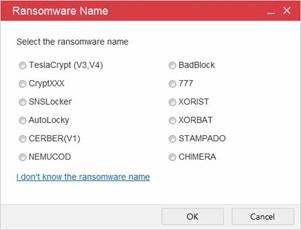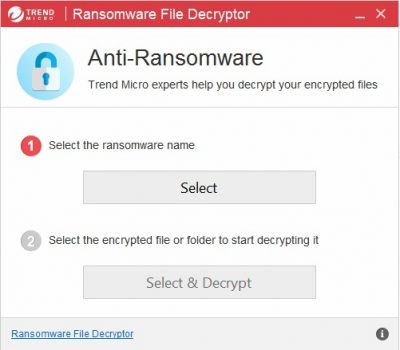Today’s malware authors are getting smarter with advancements in technology. Gone are the days when cybercriminals like these, were working as lone wolves. Now, cyber crimes are becoming an organized effort and hence Ransomware is becoming more powerful than ever before. Ransomware encrypts & locks the files on the user’s PC, and to decrypt these files, users are asked to pay a ransom. Trend Micro Ransomware File Decryptor is a free Ransomware Decryptor Tool that will help you unlock files that have been locked by select ransomware.
Trend Micro Ransomware File Decryptor for Windows
The Decryptor file is of size 11 MB, which gets downloaded within a few seconds. Unzip the file and launch the exe file. When you execute the file, you will be asked to accept the End User License Agreement (EULA) to proceed. Once the license is accepted, you will see the main window of its user interface.
As seen in this image of the main window of the Ransomware File Decryptor, you need to select the name of the ransomware. In step 2, you need to select the encrypted file or folder to start the decryption.
Trend Micro Ransomware File Decryptor will help in the following cases:
Trend Micro Ransomware File Decryptor tool, currently, will attempt to decrypt files encrypted by certain ransomware families like:
- CryptXXX V1, V2, V3
- CryptXXX V4, V5
- Crysis
- DemoTool
- DXXD
- TeslaCrypt V1
- TeslaCrypt V2
- TeslaCrypt V3
- TeslaCrypt V4
- SNSLocker
- AutoLocky
- BadBlock
- 777
- XORIST
- Teamxrat/Xpan
- XORBAT
- CERBER V1
- Stampado
- Nemucod
- Chimera
- LECHIFFRE
- MirCop
- Jigsaw
- Globe/Purge
- V2:
- V3:
- And more!
How to use Trend Micro Ransomware File Decryptor
In the first step, the user has to choose the ransomware name. The selection looks as follows:

In case you don’t know the ransomware name, you can click on “I don’t know the ransomware name” option. The tool will prompt the user to select a target file to be decrypted. The tool tries to identify the ransomware based on the file signature automatically.
In the second step, you must select the file or folder on your PC to decrypt. The tool can either attempt to decrypt a single file or all files in a folder and its sub-folders by using recursive mode. Click “Select & Decrypt”, choose a folder or a file, and click OK to start the decrypting process.
In further steps, the Trend Micro Ransomware File Decryptor starts decrypting the files based on their file extension names. In the case of some ransomware file extensions, the tool may ask you to provide additional information about the files. At some times, you will be provided with two files; one infected file and a second, matching non-infected file if there is an available backup copy. At this stage, you can select which file to be processed. Ideally, the larger-sized file should be selected; which clearly means it consists of more data.
Once the scan and decryption process is finished, the UI will show the results. The results include details such as the duration of the scan, the number of infected files and the number of decrypted files. At this stage, you can see the encrypted files’ location. The fixed file will have the same name of the original file with “_fixed” appended to the file name and will be placed in the same location.
Limitations of the decryptor tool
Though the tool is efficient enough to identify various ransomware file types and decrypts them; it may not be able to do it completely every time. This is applicable specifically to the files affected by CryptXXX V3 ransomware. For the files which are decrypted partially by the tool, users are suggested to use 3rd party recovery tools.
The creators of the tool have mentioned its limitation about the CERBER decryption as well. According to the creators of the tool, CERBER decryption must be executed on the infected machine itself (as opposed to another machine). This is because the tool needs to try and locate the first infected file for a critical decryption calculation. Further, due to the method of decryption for CERBER, the Ransomware File Decryptor may take several hours (average is 4) to complete decryption on a standard Intel i5 dual-core machine.
To download Trend Micro Ransomware File Decryptor file, click on ‘Download RansomwareFileDecryptor’ button on its home page.
Trend Micro offers another tool called Trend Micro Ransomware Screen Unlocker Tool, which helps you unlock the screen when ransomware attacks your PC and locks it. You can also use the Trend Micro AntiRansomware Tool to remove ransomware from your PC.
Can ransomware encrypted files be decrypted?
Yes, it is possible to decrypt ransomware-encrypted files on Windows 11/10 PC. However, the most difficult stage is to recognize the ransomware name that has attacked your computer. Once done, you can find the corresponding decrypt tools online and use them to decrypt your encrypted files.
How do I decrypt encrypted files?
To decrypt ransomware-encrypted files on Windows 11 and Windows 10, you need to know the name of the ransomware first. You can use various online tools to do this. Following that, you can find and use the corresponding tools to decrypt the encrypted files within moments.
There are some basic steps one can take to prevent ransomware, including making use of some free anti-ransomware software. But should you have the misfortune of getting infected then this post will tell you what to do after a Ransomware attack on your Windows computer?

I’m confused (being a not so knowledgeable pc user) . If Ransomeware freezes your pc how can a person download & open these tools & run them ? Are these tools downloaded to a thumb drive ,or on the pc itself ?
If the Ransomware has locked your computer, then you may need to use this or a different tool to unlock your computer using a USB Drive. When a Ransomware just locks your data, you will be able to still login in and use this tool.
Good advice; also, Emsisoft has some free decryptor tools for some of same and few other ever-emerging ransomwares; note some newer strains of ransomeware as “DynaCrypt” not only encrypt files, they send copies as spies plus lock one out of their user account; definitely good to not use an administrator account if unsure about protection quality of current A/V. Cheers!
Yes – The full list of decryption tools is available here: https://www.thewindowsclub.com/list-ransomware-decryptor-tools
I used the tool and it says sucessful but I cannot open the files becuase now they are damaged
ALL THE FILES IN MY COMPUTER ARE CHANGED TO THIS FILE FORMAT”._” SOLUTION NEEDED
See if something available for yours here – https://www.thewindowsclub.com/list-ransomware-decryptor-tools